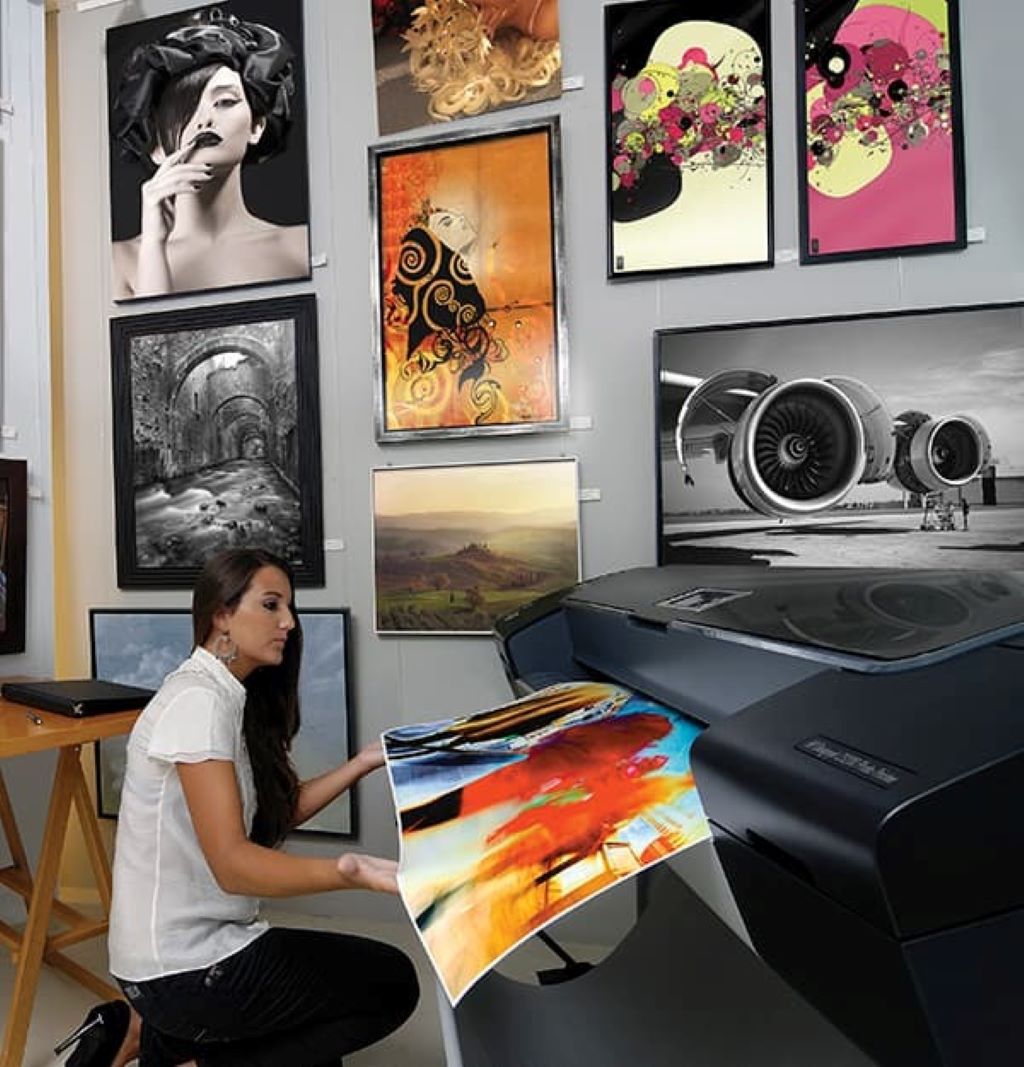Graphic design students face unique printing challenges that demand specialized equipment capable of producing professional-quality output while remaining affordable for tight student budgets. Color accuracy, print resolution, and media versatility become critical factors when selecting equipment for design portfolios, class assignments, and creative projects. The right printer can transform digital creations into stunning physical representations that showcase artistic skills and technical proficiency. Mech Office provides comprehensive guidance to help design students navigate the complex printer market and identify models that deliver professional results without breaking the bank.
Design education requires frequent printing of artwork, portfolios, presentations, and project drafts throughout academic programs. Students must produce high-quality prints that accurately represent their digital work while demonstrating color theory, composition, and technical execution to instructors and potential employers. Additionally, the ability to experiment with different paper types and print sizes enhances creative exploration and skill development.
When researching options among the top 10 printers for home use, design students must prioritize color accuracy, resolution capabilities, and media handling flexibility over basic document printing features. Therefore, understanding the specific requirements of graphic design work helps narrow printer selections to models that support creative education and professional development effectively.
Understanding Graphic Design Printing Requirements
Color Accuracy and Gamut Considerations
Color reproduction accuracy stands as the most critical factor for graphic design students, as printed colors must closely match what appears on calibrated monitors. Wide color gamuts enable printers to reproduce vibrant colors that accurately represent digital artwork, particularly important for brand identity work and illustration projects. Additionally, consistent color output across multiple prints ensures portfolio coherence and professional presentation quality.
Adobe RGB and sRGB color space support becomes essential for design students working with industry-standard software like Photoshop, Illustrator, and InDesign. Printers capable of reproducing these color spaces allow students to see how their digital work translates to print media accurately. However, monitor calibration and color management workflows require additional attention to achieve optimal results.
Pantone color matching capabilities benefit students working on brand identity projects or preparing work for commercial printing applications. While not all home printers achieve perfect Pantone matching, models with expanded color gamuts provide closer approximations than standard consumer printers. Therefore, color accuracy investments pay dividends in educational outcomes and portfolio quality.
Resolution and Detail Requirements
Graphic design work often involves fine details, small text, and precise line work that demand high-resolution printing capabilities. Minimum resolutions of 2400×1200 DPI ensure crisp text reproduction and smooth gradients essential for professional design presentation. Additionally, variable dot technology in modern inkjet printers produces photographic quality while maintaining sharp vector graphics.
Print head technology significantly impacts detail reproduction, with advanced systems providing precise ink droplet placement and size control. Micro-droplet capabilities enable smooth color transitions and eliminate visible banding in gradients. However, higher resolution printing typically requires more time and ink, affecting operational costs and workflow efficiency.
Large format capabilities allow students to print posters, banners, and presentation boards that showcase work at impressive scales. Tabloid-size (11×17 inch) printing capability provides significant advantages for portfolio presentation and classroom displays. Therefore, considering maximum print dimensions during selection ensures adequate versatility for various academic projects.
Top Printer Categories for Design Students
Professional Inkjet Models
Canon PIXMA Pro series printers represent excellent choices for graphic design students seeking professional color quality in relatively affordable packages. These models utilize advanced ink systems with multiple cartridges that enable precise color mixing and wide gamut reproduction. Additionally, the PIXMA Pro-100 and Pro-200 offer exceptional value propositions for students transitioning from basic consumer printers.
Epson SureColor series provides professional features including advanced color management tools and wide format capabilities that benefit design students working on large projects. The P400 and P800 models offer different size capabilities while maintaining professional color accuracy and media versatility. However, initial investment costs may require careful budget planning for student purchases.
HP DesignJet series targets professional designers but includes models suitable for serious students seeking commercial-quality output. These large format printers handle sizes up to 24 inches wide, enabling poster and banner production for academic projects. Therefore, shared purchases among student groups can make professional equipment more accessible.
High-Quality Photo Printers
Epson Expression Photo series delivers exceptional image quality for design students working extensively with photography or photo manipulation projects. The six-color ink system produces superior skin tones and smooth gradients essential for portrait work and fine art reproduction. Additionally, borderless printing capabilities enhance presentation options for portfolio development.
Canon imagePROGRAF series offers professional photo printing with precise color control and various paper handling options. These models excel at fine art reproduction and gallery-quality prints that demonstrate technical proficiency to instructors and employers. However, operating costs require consideration for budget-conscious students.
Specialized photo printers often provide better color accuracy than general-purpose models but may sacrifice text quality and everyday document capabilities. Students should evaluate their specific project mix to determine whether specialized photo printing justifies potential limitations. Therefore, balanced approaches often serve diverse academic needs more effectively.
Large Format Solutions
Wide format printing capabilities enable students to produce presentation boards, posters, and portfolio pieces that stand out in academic and professional settings. Tabloid-size capability represents the minimum for serious design work, while larger formats provide additional creative opportunities. Additionally, large prints demonstrate design impact and visual communication skills effectively.
Epson SureColor P400 and P800 series provide tabloid and larger format capabilities with professional color accuracy suitable for student portfolios and presentations. These models handle various media types including fine art papers and canvas materials. However, larger format printers require adequate space and higher supply costs.
Roll paper capabilities in some large format models enable continuous printing for banners and long displays, useful for environmental graphics and exhibition design projects. This capability expands creative possibilities while providing practical skills relevant to professional design careers. Therefore, format flexibility enhances educational value beyond basic printing needs.
According to research from the National Association of Schools of Art and Design, hands-on experience with professional printing equipment significantly enhances student preparation for design industry careers and portfolio development.
Essential Features for Design Work
Media Handling and Paper Support
Graphic design projects require diverse paper types including matte papers, glossy photo papers, fine art media, and specialty substrates like canvas or textured materials. Printers with versatile media handling capabilities enable creative experimentation and professional presentation options. Additionally, proper paper support prevents damage to expensive specialty media during printing processes.
Manual feed options allow careful handling of thick or delicate papers that automatic feeders might damage. Single-sheet feeding capabilities enable precise registration for specialty papers and expensive media. However, manual feeding requires more attention during printing and may slow production workflows.
Paper weight specifications indicate the range of media thickness the printer can accommodate safely. Design students benefit from printers supporting weights from lightweight papers to heavy cardstock and art papers. Therefore, checking media specifications ensures compatibility with intended project materials before purchase.
Color Management Tools
Professional color management software enables students to achieve consistent results across different printers and media types. ICC profile support allows precise color matching between screen and print output when properly configured. Additionally, learning color management principles provides valuable skills for professional design careers.
Built-in color calibration tools help maintain accuracy over time as printheads and inks age. Some professional models include spectrophotometers for precise color measurement and adjustment. However, external calibration tools may provide better results for critical color work.
Soft proofing capabilities in professional printers allow preview of print output on screen before committing expensive materials to actual printing. This feature reduces waste while enabling iterative refinement of color and composition. Therefore, advanced color tools enhance both educational outcomes and operational efficiency.
Connectivity and Workflow Integration
Wireless connectivity enables printing from laptops, tablets, and smartphones without cable constraints, important for students working in various locations around campus or home. Wi-Fi Direct capabilities allow connection without network infrastructure, useful in classroom or collaborative settings. Additionally, cloud printing support enables remote printing from campus computer labs.
USB connectivity provides reliable direct connections for large file transfers and critical printing jobs where wireless reliability might be questionable. Ethernet connectivity offers stable network printing for shared printers in student housing or collaborative workspaces. However, wireless convenience typically outweighs wired stability for most student applications.
Mobile app integration enables quick printing of inspiration images, reference materials, and work-in-progress reviews directly from smartphones. This capability supports modern design workflows that incorporate mobile research and collaboration. Therefore, comprehensive connectivity options enhance workflow flexibility and creative processes.
Budget Considerations for Students
Initial Investment Strategies
Student budgets require careful balance between capability and affordability when selecting printers for graphic design work. Entry-level professional models often provide significant advantages over consumer printers while remaining within reasonable student budgets. Additionally, considering total cost of ownership including supplies helps identify long-term value propositions.
Refurbished professional printers can provide access to higher-end capabilities at reduced costs, though warranty coverage and supply availability should be verified. Educational discounts from manufacturers may reduce initial costs significantly for verified students. However, research current pricing and availability before making final decisions.
Shared purchases among design student groups can make professional equipment more accessible while providing learning opportunities about equipment maintenance and scheduling. Shared ownership requires clear agreements about usage, maintenance, and cost sharing. Therefore, collaborative approaches can provide professional capabilities within student budgets.
Operating Cost Management
Ink costs represent the primary ongoing expense for design students, often exceeding the printer’s purchase price within the first year of moderate use. High-yield cartridges typically provide better per-page economics than standard cartridges despite higher upfront costs. Additionally, calculating cost-per-print for both black and color output helps budget for project expenses.
Third-party ink suppliers can reduce operating costs significantly, though color accuracy and longevity may differ from manufacturer supplies. Some students use third-party inks for draft prints and manufacturer inks for final presentations. However, warranty implications should be considered before using non-manufacturer supplies.
Paper costs vary dramatically based on quality and specialty requirements, with fine art papers costing substantially more than standard photo papers. Bulk purchasing and group orders can reduce per-sheet costs for expensive media. Therefore, strategic supply management helps control overall printing expenses.
Software Integration and Workflow
Design Software Compatibility
Adobe Creative Suite integration becomes crucial for design students using industry-standard software for coursework and projects. Proper printer drivers and color profiles ensure accurate output from Photoshop, Illustrator, and InDesign workflows. Additionally, direct printing from design applications streamlines production processes and maintains color accuracy.
Color management within design software requires understanding ICC profiles, rendering intents, and color space conversions for optimal results. Many professional printers include custom profiles for specific paper and ink combinations. However, learning color management principles provides valuable skills beyond specific printer selection.
Print preview capabilities within design software help identify potential issues before committing to physical printing. Soft proofing shows how colors will appear in print while allowing adjustments in the digital file. Therefore, software integration enhances both efficiency and output quality significantly.
File Preparation Best Practices
Resolution requirements for different print sizes affect file preparation and printing workflow efficiency. Design students must understand optimal resolution settings for various output sizes to balance quality and file management. Additionally, proper resolution prevents over-processing and reduces printing times.
Color mode considerations include understanding when to use RGB versus CMYK color spaces based on printer capabilities and output requirements. Many home printers work optimally with RGB files despite using CMYK inks internally. However, understanding color mode implications helps achieve intended results consistently.
Bleed and margin requirements affect layout design for projects intended for trimming or mounting. Proper file setup prevents cropped elements and ensures professional presentation quality. Therefore, understanding print production requirements improves final output quality and professional appearance.
Maintenance and Longevity
Printhead Care and Cleaning
Regular printhead maintenance prevents clogs and ensures consistent print quality essential for design work. Automated cleaning cycles remove dried ink and debris but consume supplies, affecting operating costs. Additionally, manual cleaning procedures may be necessary for severe clogs or extended periods without use.
Print frequency affects printhead health, with regular use preventing ink from drying in nozzles. Students with irregular printing schedules should perform test prints periodically to maintain printhead condition. However, excessive cleaning wastes ink and may cause premature printhead wear.
Environmental factors including temperature, humidity, and dust exposure affect printhead longevity and performance. Proper storage and operating conditions extend equipment life while maintaining print quality. Therefore, printer placement and care significantly impact long-term performance and costs.
Supply Management
Ink inventory management prevents interruptions during critical project deadlines while avoiding waste from expired supplies. Ink cartridges have limited shelf lives that affect color accuracy and reliability over time. Additionally, buying supplies strategically during sales periods can reduce overall costs significantly.
Cartridge storage requirements include temperature and light protection to maintain ink quality and prevent premature degradation. Proper storage extends supply life while ensuring consistent color output when used. However, excessive inventory ties up student budgets in supplies rather than equipment upgrades.
Compatible cartridge options may provide cost savings but require careful evaluation of color accuracy and reliability for design work. Some students use compatible cartridges for draft work and original cartridges for final prints. Therefore, balanced approaches can optimize both costs and quality outcomes.
According to PC World, graphic design students who invest in quality printing equipment during their education demonstrate significantly better portfolio presentation and job placement rates compared to those relying solely on commercial printing services.
Professional Development Benefits
Portfolio Presentation Advantages
High-quality printed portfolios create lasting impressions during job interviews and client presentations that digital portfolios cannot match. Physical prints demonstrate attention to detail and technical proficiency while providing tangible examples of design capabilities. Additionally, printed portfolios remain accessible regardless of technology availability or compatibility issues.
Print quality directly reflects on design skills and professionalism, making printer selection crucial for career development. Consistent color accuracy and sharp detail reproduction showcase technical competence alongside creative abilities. However, poor print quality can undermine otherwise excellent design work.
Portfolio format flexibility enables students to experiment with different presentation styles and sizes that highlight specific strengths or project types. Custom sizing and specialty papers can differentiate student work from standard presentations. Therefore, printing capabilities directly impact portfolio effectiveness and professional opportunities.
Industry Preparation
Understanding print production processes provides valuable knowledge for professional design careers where print specifications and limitations affect design decisions. Hands-on printing experience develops troubleshooting skills and color management expertise valued by employers. Additionally, familiarity with professional equipment prepares students for workplace responsibilities.
Color theory application in print contexts deepens understanding of design principles while providing practical experience with color relationships and reproduction limitations. This knowledge applies to both print and digital design work throughout professional careers. However, theoretical knowledge requires practical application for full comprehension.
Technical skills development through printer operation and maintenance provides problem-solving experience and equipment familiarity that benefits professional advancement. Understanding equipment capabilities and limitations helps designers make informed decisions about project feasibility and production methods. Therefore, hands-on experience enhances both technical skills and creative confidence.
Conclusion
Selecting the best home printer for graphic design students requires balancing professional capabilities with budget constraints while prioritizing color accuracy, resolution, and media versatility essential for creative education. Quality printing equipment enables students to produce professional portfolios, experiment with different media, and develop technical skills valuable for design careers. Additionally, hands-on printing experience provides practical knowledge about color management and production processes crucial for professional success.
Key factors include color gamut capabilities, resolution specifications, media handling flexibility, and long-term operating costs that affect both educational outcomes and budget sustainability. Professional inkjet models typically provide the best balance of capabilities and affordability for serious design students. However, individual needs and budget constraints may favor different approaches including shared equipment or refurbished professional models.
The investment in appropriate printing equipment pays dividends through enhanced portfolio quality, expanded creative possibilities, and valuable technical experience that supports both academic success and career preparation. Modern printers offer impressive capabilities that rival commercial equipment while remaining accessible to student budgets with careful selection and planning. Therefore, choosing the right printer becomes an investment in both education quality and professional development that benefits students throughout their design careers.
Frequently Asked Questions
What’s the minimum color gamut I should look for in a design printer? Look for printers covering at least 95% of sRGB color space and preferably 80-90% of Adobe RGB for professional design work. Wide gamut printers with 8-12 ink systems provide the best color reproduction for design students. Additionally, check manufacturer specifications for specific color space coverage percentages.
How much should a graphic design student budget for printing supplies annually? Expect to spend $300-600 annually on ink and paper supplies depending on project volume and quality requirements. Heavy users or those printing large formats may spend significantly more. Therefore, factor ongoing costs into your printer selection decision alongside initial purchase price.
Is it better to buy a photo printer or general inkjet for design work? Photo printers typically offer superior color accuracy and wider gamuts beneficial for design work, but may lack text quality for mixed documents. Consider your project mix and whether you need document printing alongside design output. Additionally, specialized photo printers often provide better fine art paper support.
What paper sizes should I prioritize for design school projects? Tabloid size (11×17 inches) capability provides significant advantages for portfolio presentation and classroom displays. Letter size handles most assignment requirements, while larger formats benefit poster and presentation projects. However, consider available workspace and storage when evaluating large format capabilities.
Can I achieve professional results with entry-level printers? Entry-level models from professional lines often provide significantly better results than consumer printers while remaining budget-friendly. Focus on color accuracy specifications and gamut coverage rather than advanced features you may not need. Therefore, strategic selection of entry-level professional models can deliver excellent results for student budgets.
Read More:
IMPORTANT ELEMENTS TO WORKING AT HOME SAFELY




